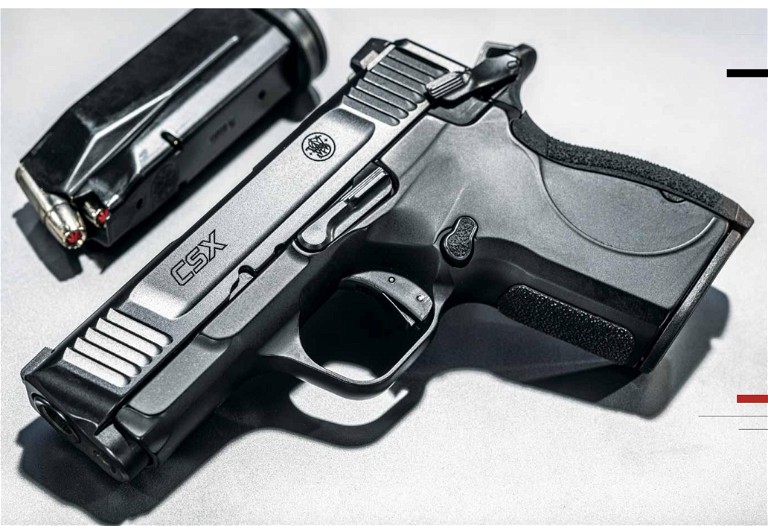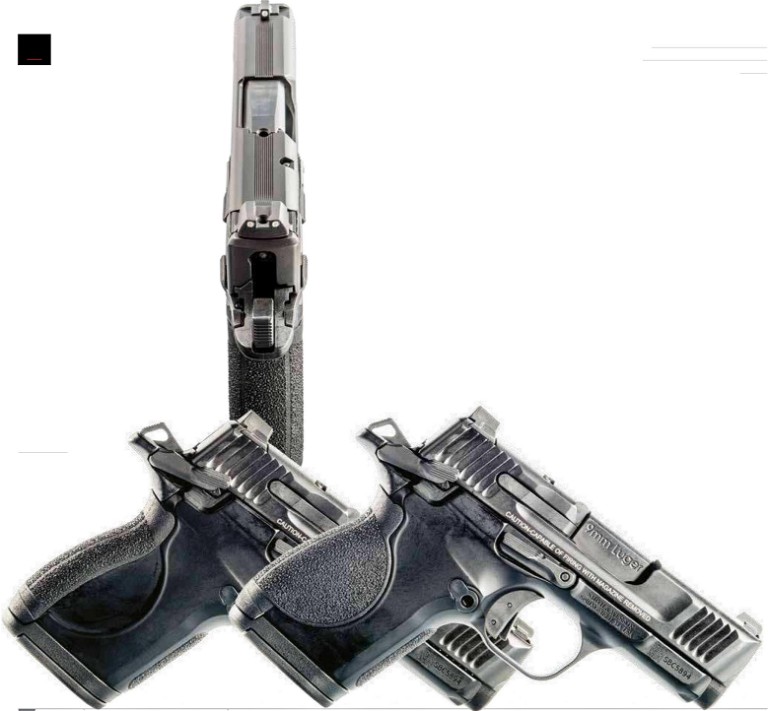BOB CAMPBELL
MODERN ART
SMITH & WESSON CSX 9MM

A NEW OLD IDEA
With an aluminum-alloy frame and a singleaction trigger, the new CSX feels familiar but isn’t quite like anything else on the market.
SPECIFICATIONS
MANUFACTURER: SMITH & WESSON MODEL: CSX CALIBER: 9MM
CAPACITY: 10+1; 12+1 ACTION: SINGLE-ACTION OVERALL LENGTH: 6.1 INCHES HEIGHT: 4.6 INCHES
WIDTH: 1.12 INCHES WEIGHT: 19.5 OUNCES BARREL/SLIDE MATERIAL: STAINLESS
STEEL ARMORNITE FINISH FRAME MATERIAL: ALUMINUM ALLOY SLIDE/FRAME FINISH: MATTE BLACK FRONT SIGHT: METAL WHITE DOT REAR SIGHT: METAL WHITE 2-DOT
MSRP: $609
Smith & Wesson recently introduced the CSX to pay homage to past metal-frame micro-compacts and also to offer its classic style to modern buyers. I was surprised to find the pistol on the “used” shelf at a local gun shop. Apparently, a fellow gun owner didn’t get the hang of it and traded it back in for a Smith & Wesson Shield.
His loss is my gain.
The CSX reminded me of a couple single-action pistols I’ve greatly appreciated in the past, including the Star Firestar Plus. With that in mind, I took possession of the CSX after filling out the required paperwork and wound up impressed with what it has to offer.
LUCKY FIND
The CSX is either a compact or subcompact pistol (depending on who you ask). It is slightly smaller than the Smith & Wesson Shield Plus, which is just the right size. If the Glock 19 is considered a compact pistol, the CSX is definitely a subcompact.
It is a locked-breech, single-action 9mm, which means the trigger doesn’t cock and drop the hammer as it does in a double-action system, nor does it move the striker to the rear as in the Glock Safe Action System. As a result, your trigger finger won’t follow an arc to operate the trigger but instead will press straight to the rear.
The trigger breaks at 6 pounds, and compression is clean, with modest take-up and a sharp break. Reset is rapid, and the trigger is flat (with the exception of a slight curve at the very top). A lever inset in the trigger face prevents lateral discharge, and it ships with a spare magazine release if you wish to reverse it for left-handed use.
The short slide features forward and rear cocking serrations and is finished in corrosion-resistant Armornite. Though you will use the forward serrations most, the rear serrations have a flared design for easier manipulation. There is a serrated line cut into the slide between the wedge-type rear sight and the front unit, and both sights combine for a white three-dot picture.
The CSX includes two grip inserts, and the smaller, flatter unit worked best for my average-sized hands. Changing the insert is easy to do, as Smith & Wesson supplies a tool to depress the plunger that holds the grips in place.
The frame has a nicely elongated tang, which helps feed the hand into the backstrap, which is an excellent feature on a pistol of this size. The slide lock and safety are ambidextrous, though the safety does not lock the slide as the safeties on 1911 and Hi Power single-action pistols do. The pistol may be loaded and unloaded with the safety on, which is an advantage in some situations. The safety may also be applied with the hammer down. There is a half-cock notch that will capture the hammer in the event that the user slips while cocking the hammer, but do not use half-cock as a “ready mode” in any type of single-action pistol.

FITTING ROOM
The interchangeable smaller (left) and larger (right) backstraps make the CSX customizable beyond other pistols of comparable size.
“ GETTING ON TARGET AT 7 YARDS, I WAS ABLE TO REMOVE THE X-RING OF A B-27 TARGET. THIS IS AS GOOD A SHOOTER AS I HAVE ENCOUNTERED IN A PISTOL OF THIS SIZE AND WEIGHT. ”
Carrying the pistol in a holster with the hammer to the rear and the safety on is the recommended carry method. While the CSX isn’t the smallest pistol, I can see the usefulness of this handgun in a well-made ankle rig — one manufactured by CrossBreed, for instance. Still, the CSX is a natural for a quality IWB holster, and the Galco Stow-N-Go for the Glock 43X is a perfect fit. Galco’s Tuck-N-Go works well too; I don’t like tuckable holsters all that much, but the Tuck-N-Go features a belt clip that is absolutely rigid and locks up solid. If you must have a tuckable, this is your best option.
Of two magazines that are supplied with the pistol, the 10-rounder is a flush-fit, and the 12-rounder extends past the frame slightly, but only by an eighth of an inch or so. There is no practical difference between the two magazines when it comes to concealment, either in the gun or on the belt. The good news is that both of these steel magazines are well-made, but the bad news is that the 12-round magazine is difficult to load to full capacity. I managed 11 at the first range session; only weeks later, after leaving the magazine loaded for days, was I able to force that 12th cartridge in.
LINE REPORT
This is a subcompact with a short sight radius, so you must take greater care with the sight picture and trigger press than with a full-sized gun or you will throw shots. Accuracy is still well within reach though, as the sights and trigger are both more than adequate. That said, pressing a 6-pound trigger against a roughly 20-ounce pistol is a balancing act (though for comparison, I am able to fire this pistol at least as well as a SIG Sauer P365 and better than a Smith & Wesson Shield Plus).
The grip isn’t generous, but it is well-designed, and the pistol comes on target quickly. The safety is positive in operation and falls under the thumb easily. Getting on target at 7 yards, I was able to remove the X-ring of a B-27 target. This is as good a shooter as I have encountered in a pistol of this sizeand weight.
Perhaps not surprisingly, most of the ammunition expended for this assessment was inexpensive ball ammunition. Some cheap (whatever passes for “cheap” these days) ball is pretty good, but most is dirty, and a lot of what we see today is loaded either too light or too hot. I fired a supply of Turkish 9mm FMJ that is clean-burning, accurate and apparently NATO-spec. While snappy, it was controllable in the CSX. I also fired a number of modern jacketed hollow-points, including Federal HST, Hornady XTP, Remington Golden Saber and Winchester Silvertip.
The feed reliability was flawless, and as for absolute accuracy, at 15 yards from a solid benchrest position, I was able to fire three-shot groups of 2.5 to 3.2 inches. This lands the CSX squarely in the realm of “accurate enough for any foreseeable personal-defense problem.”
UPGRADE ON PROVEN PRINCIPLES
The CSX never failed to feed, chamber, fire or eject. It is accurate, reliable and offers an alternative to generic striker-fired polymer-frame pistols. In short, it is a unique, excellent update on proven principles. The CSX is for the shooter who isn’t finding what he or she likes in a crowded market, and it is a fine option for the concealed carrier who is looking for something a little different.
SOURCES
CrossBreed Holsters:
Galco Holsters: GalcoGunleather.com
Smith & Wesson: Smith-Wesson.com